
| What is Flavor and Fortune? |
| How do I subscribe? |
| How do I get past issues? |
| How do I advertise? |
| How do I contact the editor? |
Read 12879171 times
Connect me to:
| Home |
| Articles |
| Book reviews |
| Letters to the Editor |
| Newmans News and Notes |
| Recipes |
| Restaurant reviews |
| Article Index (all years, slow) |
| List of Article Years |
| Article Index (2025) |
| Article Index (last 2 years) |
| Things others say |
| Related Links |
| Log In... |
| Authors |
| Categories & Topics |
Dai and Their Dishes
| by Jacqueline M. Newman |
Chinese Ethnic Minorities and Their Foods
Fall Volume: 2012 Issue: 19(3) page(s): 18 - 21, and 35 - 36
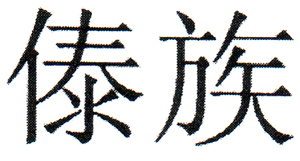 Known as Dai, Tai and Daizu, also Daili, Dianyue, Diana, Daiya, Pu, Yue, Liao and still other names, this group of people originated in southern Yunnan thousands of years ago. They are one of China's fifty-five recognized minority populations. These populations all together are some of the eight and a half percent of China's total minority groups. The most recent census said there are one and a half million Dai in China, some twenty thousand in Kunming, Yunnan’s capital. Most others live near China's borders with Myanmar and Laos.
Known as Dai, Tai and Daizu, also Daili, Dianyue, Diana, Daiya, Pu, Yue, Liao and still other names, this group of people originated in southern Yunnan thousands of years ago. They are one of China's fifty-five recognized minority populations. These populations all together are some of the eight and a half percent of China's total minority groups. The most recent census said there are one and a half million Dai in China, some twenty thousand in Kunming, Yunnan’s capital. Most others live near China's borders with Myanmar and Laos.
There were Dai kings, the last one abdicated in 1953 and many say he did so under pressure from China's rulers, but there is no proof of that. The Dai were more popular during the Wei and Jin Dynasties (220 - 589 CE) when they were known as Jinchi, Yichi, and Baiyi, and known by these names, as well in the Tang and Song Dynasties (618 - 907 CE and 960 - 1279 CE), respectively. Some called this population Bayi, and that was in the Qing Dynasty (1644 - 1911 CE). After the founding of new China, they selected the name Dai themselves for their nationality.
Some say the reason there are so many names for this ethnic group is because they have or are one of four, five, even eight main ethnic branches. If four, these include the Sui, Han, Huayao, and Kemu Dai. If five, they are the White Dai, Black Dai, Flower Dai, Dryland Dai, and Water Dai. For those who say there are eight different Dai populations, their names might be any of the above and/or any others. We could find no nomenclature agreement but did find most Dai living in the sub-tropical monsoon region of China, a small number in Myanmar which was previously called Burma, and quite a few in Laos, Vietnam, and in Thailand. Those in China are a tourist attraction, particularly if they live in Xishuangbanna. That is mostly because of their distinctive dress.
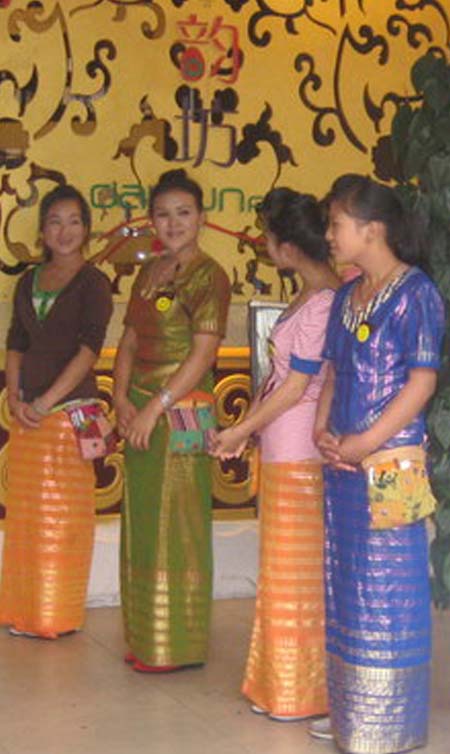 Every Dai population has their own distinct dress, and some have their own written and spoken languages. All belong to the Zhuang-Dai branch of the Zhuang-Dong group and speak a language in the Sino-Tibetan language family. To complicate things further, their written language uses four different kinds of writing, known as Daili, Diana, Daibeng, and Daiduan, and a few told us some of their words do have Indian or Sanskrit roots.
Every Dai population has their own distinct dress, and some have their own written and spoken languages. All belong to the Zhuang-Dai branch of the Zhuang-Dong group and speak a language in the Sino-Tibetan language family. To complicate things further, their written language uses four different kinds of writing, known as Daili, Diana, Daibeng, and Daiduan, and a few told us some of their words do have Indian or Sanskrit roots.
Not only do all Dai not wear the same clothing, they do not have the same belief systems, nor did they have the same occupations. Many earn a living breeding buffalo, probably why their name translates to 'group of the water.' Others grow and grew lots of rice and other food and non-food items.
The history of this minority group began long before the early part of the first century. Now, as one of the more than twenty minority groups living the Yunnan Province, most live in the southwestern Autonomous Prefectures of Dehong Jingpo, in Xishuangbanna, and in the Gengma, Menglian, Yuanjiang and Xinping autonomous counties, and as indicated, in several neighboring countries.
In the Dehong Dai and Jingpo Dai Autonomous Prefectures where others live, their capital city is Mangshi, now more commonly called Luxi City. Living here is not new for the Dai. There are written records of several of their tribes living there circa 42 CE where they evolved into those we know today as Deang and Dai. The capital of Xishuangbanna, where another large group of Dai live is Yunjinghong, a city about eight hundred and fifty years old; its name meaning 'city of dawn.' This city has this name because a young man fought a ruling demon for seven days and nights then strangled it here. That accomplished, he hung a pearl on a coconut tree to celebrate, and that pearl is said to have pierced the city's darkness, hence the name of 'City of Dawn.'
During the Ming Dynasty (1368 - 1644 CE), China's emperor appointed a chief to unite this region. He was Dao Yingmeng, and he served as the local governor. In 1953, this city became the official capital of the prefecture. People here speak their own language and Chinese, both are now taught in local schools. They write their language and it is interesting to note that it includes four phonetic characters evolved from ancient Brahmi letters.
Years ago, boys at about age eight, went to school in Buddhist temples where they learned their own oral and written languages, and Hinayana Buddhism. Now, they learn in local public schools, and quite a few do get Buddhist education, but after school.
On the fifteenth day of their sixth lunar month there are dantan activities most participate in. These are the copying of sutras and the making donations to the temple. Older religious people do so every seventh day after a high-level monk chants both for and about them. These temple donations can be food items such as instant noodles, or toothpaste, towels, clothing, some glutinous rice, soups, and money.
Temple donations are important to the Dai as many of them worry their offspring will forget to make donations in their name after they die. Should that happen, they believe they will face poverty in their afterlife. As Dai want to be cremated, there are few cemeteries to visit; so these donations honoring the deceased are of great importance.
At the other end of life, when a Dai baby celebrates its one-month birthday, a high monk or a retired one, ties a thread on the baby’s wrist. Mother, grandmother, or an elder relative prepare a brocade the size of an adult palm to record this date and the time of the birth. They keep this item until death; and relatives see that this brocade is cremated with them.
Most Dai are still farmers, though some have started industries including processing the rubber they grow, packaging fertilizers to improve their crops, and building and running factories to make machines for their industries. One of these is the packing and selling their beloved glutinous and non-glutinous rices.
Both of these rice types are Dai staples. The glutinous one is preferred in Xishuangbanna, the non-glutinous variety liked better in the Dehong region. They also grow, package, and consume lots of pineapple, tea, bamboo, coconut, jackfruit, coffee, papaya, banana, mango, many other fruits and vegetables. All of these foods can be used as temple donations.
In both prefectures and elsewhere, the Dai like either of their rices roasted. They soak some for about half an hour, put it in bamboo tubes and wrap these in banana leaves. This rice is roasted over an open fire and when fully cooked, the bamboo tube is slashed open with a large knife and served with roasted fish or roasted chicken, both made boneless and rubbed with sesame oil before and/or after cooking.
When Dai have guests, they greet them serving a favorite dish, their moss pie. To make it, they collect or purchase moss and dry it, mix it with rice, make it into patties, and fry these patties. These are served with fried or steamed bamboo, plain, steamed, or fried vegetables, and pork and/or other meats, or with grilled beef or fish. These foods are placed on freshly cut banana leaves and put on low tables on their open porches. They like to eat outside and these porches are on the upper story of their homes which are often built on stilts. Actually, most houses are on stilts about six feet above ground level; below, they keep their animals and large tools. Smaller tools are kept on these porches.
Many Dai dishes are sour, their vegetables sour or preserved, and many also a bit spicy. The sour comes from drying their vegetables first, then boiling them with papaya juice, then drying them again so they are available in all seasons. At most meals, these vegetables are cooked with bamboo shoots and with something they call 'minced raw' which is raw meat mixed with salt, pepper, lemon grass, and a touch of hot pepper. Most Dai dishes come to the table with a piquant sauce on the side, and diners can add as much as they like to any food. If their rice is not cooked in bamboo, they like it steamed in a pineapple or stir-fried and then added to a hollowed out pineapple.
As to beverages, Dai love wine and liquor and they like them best when consumed with betel nuts. They also enjoy a low alcoholic beverage called shuyiu, which is made from fermented glutinous rice. They also drink tea, but most often consumed between meals. At meals they like to drink the water their vegetables are cooked in.
When about eighteen, a Dai boy can select his own partner; of course with her consent. With friends, he and they set up a bridal chamber, usually nearby. Later he kidnaps this girl and carries her away to this room; the wedding is held in it, too. They consummate their union, and some three days later with matchmaker in tow, he or they bring rice wine, brown sugar, pork, chicken, and rice to her parents who feel compelled to consent to the wedding.
As they need a place to live, a new home is built, and before moving in, it is common for four elders to cook four eggs and read scripture praying for their good life in it. After that, they move in. Should you be invited to visit, removes your shoes on the top step of their living area. Take a look at their animals penned in below the living space or tethered to trees nearby. Their outside may have fruit trees planted for shade, show, and sustenance.
On the living level will be a fire pit where they cook, eat, and entertain guests. Private space is the inner or center part of the upper level. Many families sleep in one room on mats; it can be divided by curtains. If a multi-generational family, each generation has its own mosquito net and curtains, some quite colorful. A single girl can share a netting with her female siblings, and it often has white curtains. When an older one has a beau, the others take their mats and bed down on the porch or with their parents.
Boys at about eleven begin getting their body covered with tattoos. These are of animals, flowers, writing, and geometric designs; they are done on their backs, chest, arms, and legs. They like to show them off. Girls show off their patterned clothes, wrap-around skirts, tight blouses, and long hair coiled on top of their heads at an angle or in another fashion. Each Dai group has its own dress, hair style, and tatoos. Girls and women also like to show off their glittering silver or gold dental work and the silver belt they wear around their waist.
While their clothes and coif are not food related, dating certainly can be. For example, when a girl wants to find a man, she can stew a chicken and tote it to market. Men look and smell, even offer money, but it is not for sale. It is for the chap she likes, one perhaps met at a water-splashing festival. If he accepts, they go off to some private place to enjoy it and each other.
Dating is encouraged. Parents leave their fire pit to the girl who uses this space to get to know a young man. If not, she gets to know him behind a sleeping space set aside for this activity or the one where her siblings disappear so she has some privacy.
Once married, Dai women do not move, the groom moves in to live with her or with her parents. When he first arrives after the marriage, he must present a 'gate-opening' gift to get on to the property. Then he needs a 'door-opening' gift for the family to unlock the real or titular door and enter their living space. Another gift is needed when 'introducing the bride,' that is when she comes out to see him and his family. The groom and his family and friends come carrying a table loaded with gifts. Only after all of these activities can he actually move in.
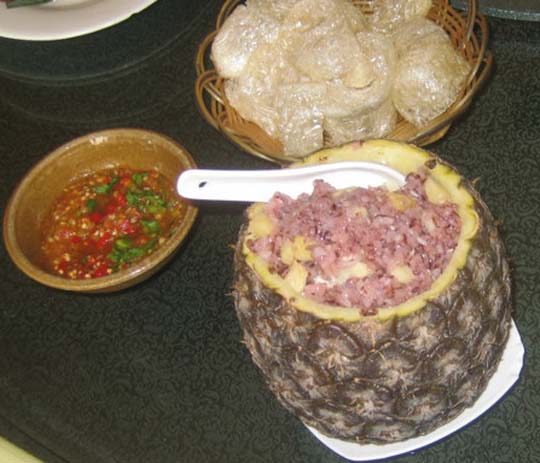 On the holiday scene, Dai celebrate New Year, a three-day festival, that begins 'Bathing the Buddha' and ends with the Water-splashing Festival. Their New Year is in mid-April of the Gregorian calendar, the sixth month of their lunar calendar. This is different from the Han whose New Year is the end of January or the beginning of February. This holiday begins when women take the Buddha out of the temple to wash him with clear water. Some call this day by another name, that is the Clear Water Festival. Monks chant scriptures and people present the Buddha with flowers. Some young folk start a few days early and take some of the water used that day and splash each other believing it will ward off evil spirits. The highlight of the festival is the third day when everyone's spirits are heightened and the splashing increases. This day is the real Water Splashing Festival.
There is a tale about this festival and a demon plied with food and drink by a lovely young lady. He tells her, when inebriated, his head will fall off if tied about the neck with a silk thread. He even advises it will burst into flames. Once very drunk, she does tie that string, other young girls gather water and splash his head to put out the initiated flames. This Water-splashing can go on for three days. It often does, and it can include Dragon Boat races and other activities.
On the holiday scene, Dai celebrate New Year, a three-day festival, that begins 'Bathing the Buddha' and ends with the Water-splashing Festival. Their New Year is in mid-April of the Gregorian calendar, the sixth month of their lunar calendar. This is different from the Han whose New Year is the end of January or the beginning of February. This holiday begins when women take the Buddha out of the temple to wash him with clear water. Some call this day by another name, that is the Clear Water Festival. Monks chant scriptures and people present the Buddha with flowers. Some young folk start a few days early and take some of the water used that day and splash each other believing it will ward off evil spirits. The highlight of the festival is the third day when everyone's spirits are heightened and the splashing increases. This day is the real Water Splashing Festival.
There is a tale about this festival and a demon plied with food and drink by a lovely young lady. He tells her, when inebriated, his head will fall off if tied about the neck with a silk thread. He even advises it will burst into flames. Once very drunk, she does tie that string, other young girls gather water and splash his head to put out the initiated flames. This Water-splashing can go on for three days. It often does, and it can include Dragon Boat races and other activities.
Other Dai Festivals include Door-shutting and Door-opening days. The former is in the sixth lunar month, the latter in the twelfth month after the rainy season and concurrent with celebrating the harvest. The Dai can engage then and at other times in a traditional martial art called Dai-boxing. It uses lower limbs and fancy footwork. This exercise is accompanied by an elephant-foot drum and a mangluo which is a Dai musical instrument. With three rice harvests, times for festivities are not limited and are very appreciated.
During holiday times, the Dai celebrate with special dishes such as Roasted Chicken with Coriander, or Chicken with Pickled Bamboo Shoots, Onions, and Ginger. These chicken dishes are made with black chickens, those with the silky white feathers. Other Dai dishes, holiday or no, include Quick Boiled Beef in Clear Soup, Glutinous Rice Cakes plain or with nanmi which is their chili sauce. They also make special dishes such as Sour Bamboo Shoots with Beef, Sapie which is a collection of Dai cold dishes including ox intestine, bile, beef, Chinese Chives, and Mint and Tomatoes.
At mealtimes, Dai love Grilled Stuffed Fish, Fried Cattle Skin, Fried Lichen, Fried Sour Banana Slices, fatty Meat Stuffed in Green Pepper, Baked Dried beef, Corn Fish with Pineapple, and Pineapple Rice, also Dai Tart Herbs made sweet and sour, Vinegar-pepper Chicken, Wind-dried Liver, Steamed Herbal Eggs, Sweet Eggs in Pumpkin, Fried sour Banana Slices, and Baked Tea.
A small amount of detail about some popular foods follows as do a few Dai recipes. A future issue will share more about this and other minority populations, their customs, culture, and culinary. Now about some Dai foods:
FRIED CATTLE SKIN is popular and made using the skin of a cow or an ox that they boil for several hours, then slice it thin, and dry it in the sun. When ready, it is fried in deep oil until it turns yellow and curls up as if rolled. Then it is drained and eaten with a spicy sauce for dipping or broken into smaller pieces and added to a soup or a stir-fried dish. It can be seen with the rice-stuffed pineapple above.
ROASTED FISH 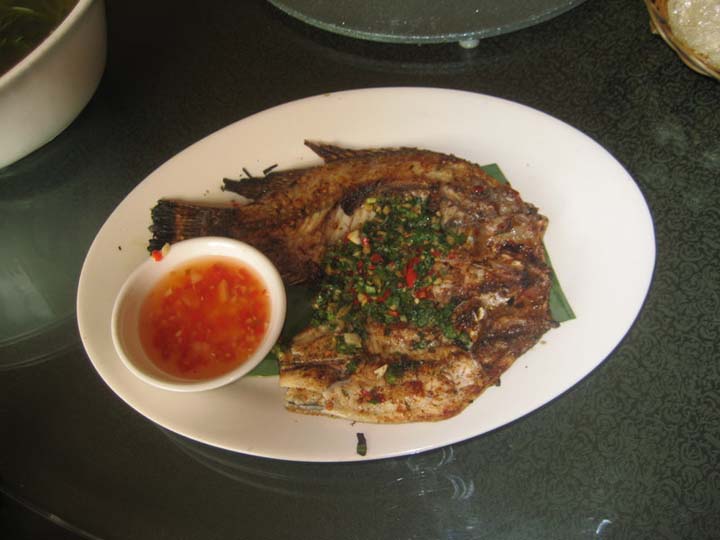 is adored and made one of two ways. More popular is to make a stuffing with onions, coriander, hot peppers, and salt, bone the fish and stuff this between the halves, then tie them together with dried congrass, bamboo, or other soaked leaves and roasted over a charcoal fire. Restaurants bone the fish leaving its halves attached; some put the stuffing on both halves and fry, broil, or roast the fish.
is adored and made one of two ways. More popular is to make a stuffing with onions, coriander, hot peppers, and salt, bone the fish and stuff this between the halves, then tie them together with dried congrass, bamboo, or other soaked leaves and roasted over a charcoal fire. Restaurants bone the fish leaving its halves attached; some put the stuffing on both halves and fry, broil, or roast the fish.
CORN FISH can be cooked in a hollowed out pineapple after the fish is scaled and sliced. The juice of this fruit is poured in, and the pineapple steamed. Sometimes the fish is cut on two angles and looks like corn, or it is coated with a flour paste and made to look like corn.
BAKED DRIED BEEF 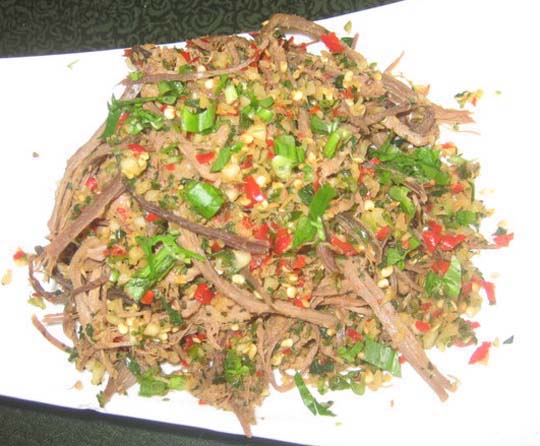 is cow or ox sliced, slivered actually, and mixed with thin sticks of raddish, garlic, and hot peppers. These are then baked in or on a fire, or dry-fried before serving.
is cow or ox sliced, slivered actually, and mixed with thin sticks of raddish, garlic, and hot peppers. These are then baked in or on a fire, or dry-fried before serving.
BAKED TEA is said to have originated in the city of Dali. It is flat and pancake-shape, thicker in the center than around its edges, and different from pressed tea made toucha style. Somewhat like Sandao Tea, this tea is baked.
TOUCHA TEA is dried, round, and with a depression under its center. Both are popular beverages, rarely served with main meals. They are served at breakfast and during the noon hour, sometimes with snacks, and rarely with or after dinner. At their evening meal or before it, Dai like to have rose wine or safflower wine with roasted peanuts, spicy pickled vegetables, or both.
| Steamed Moss Pie |
|---|
10 bamboo pith mushrooms 1 and 1/2 cups dried black moss, in Chinese, fa cai 10 Shanghai cabbage, their lower ends sliced off 1/4 teaspoon salt 1/2 teaspoon sugar dash ground white pepper 5 black mushrooms, soaked, stems discarded, and sliced in quarter-inch pieces 1 teaspoon finely minced fresh ginger 1 Tablespoon ginger juice 2 Tablespoons Yunnan ham, slivered 10 long scallion pieces 1 Tablespoon oil 1 and 1/2 cups chicken stock 1 teaspoon oyster sauce 1 teaspoon thin soy sauce 2 Tablespoons Chinese rice wine 2 Tablespoons cornstarch mixed with one tablespoon cold water Preparation: 1. Soak bamboo pith in warm water for ten minutes, then cut both ends off each one, cut them into one-inch squares and blanch in boiling water for one minute, drain and squeeze out excess water. 2. Soak black moss for one hour in cold water, rinse it and drain it well. Then blanch it in boiling water for one minute, drain and squeeze out excess water. 3. Cut cabbages in half the long way, and blanch in boiling water for one minute, then drain and squeeze out any excess water. 4. Make a mixture of mushroom slices, fresh ginger, and ham and divide it into ten batches. 5. Wrap two halves of the cabbage around one-batch of the mushroom mixture and tie each with one piece of scallion. 6. Put some black moss on each package, and place on an oiled plate on a steamer basket and steam over boiling water for twenty minutes, then remove to a serving platter. 7. Heat the stock, oyster and soy sauces and the wine and the cornstarch and water mixture until it thickens, then pour this over the moss pies and serve. |
| Mint and Tomatoes, Dai Style |
|---|
3 cloves garlic, minced 1/2 teaspoon salt 1/4 fresh chili pepper, minced 3 scallions, cut lengthwise into half-inch very thin slivers 1 cup mint leaves, coarsely chopped 6 green-turning red tomatoes, diced 2 teaspoons hot chili oil Preparation: 1. In a mortar and pestle, pound garlic and salt until partially mashed. 2. Add chili pepper and scallion pieces and mash for half minute more, then add tomatoes and continue to mash for another half minute, then stir thoroughly. 3. Add chili oil, stir well, and then remove solids to a serving bowl. Pour remaining liquid over this mixture, and serve. |
| Grilled Stuffed Fish, Dai Style |
|---|
1 two-pound fish, cut in half, the skin not separated, and debone the fish and discard the bones 1/2 teaspoon ground white pepper 1 teaspoon coarse salt 1 cup coarsely chopped scallions 1/2 cup minced mostly fat from a piece of belly pork 1 fresh red chili pepper, seeded and cut into small pieces 3 cloves garlic, coarsely chopped 1 slice onion, chopped 2 Tablespoons chopped fresh coriander, optional 1 to 2 pieces of congrass or banana leaves or aluminum foil and string 1 teaspoon vegetable oil, if using aluminum foil Preparation: 1. Dry fish inside and out, then cut slashes about two-inches apart on the skin side, being careful not to cut more than one-quarter-inch deep, and not all the way through the flesh. 2. Rub both sides first with ground pepper, then with the coarse salt. 3. Using a mortar and pestle, pound scallions, the fat, chili pepper pieces, the chopped garlic and onion, and the coriander, if using it, making a coarse paste. 4. Take one teaspoon of the paste and rub it on the skin side of the fish, spread the remaining paste evenly on one side of the flesh of the fish, and cover with the other side. 5. Pull off a few thin pieces of the congrass or the banana leaf to use as string; or oil one side of the aluminum foil; and wrap one or the other around the fish and tie to hold the filling in and the sides together around the stuffed fish. 6. Grill over charcoal about five minutes per side, but grill each side twice, then remove the wrapping or not, as desired, and serve. |
| Eggs in Pumpkin, Dai Style |
|---|
1 small pumpkin (or a coconut shell, if preferred) 8 eggs, beaten well, chalaza or thick part discarded 1 cup sugar 1 and 1/2 cups coconut milk Preparation: 1. Cut off one-quarter inch of the top of the pumpkin and remove the seeds and stringy part. 2. Beat eggs with the sugar, then add te coconut milk and pour this liquid into the pumpkin. 3. Put the pumpkin in a bowl and into a steamer with two inches of water in the bottom part. Cover and steam over rapidly boiling water. Check it every ten minutes to see if more water is needed. Test the center by putting a toothpick into the egg part and see if it comes out clean. If not steam for another ten minutes. 4. Remove bowl with the pumpkin and cool for one hour, then refrigerate for four hours or overnight. 5. Serve whole and cut into wedges at the table, and serve as part of a main meal. |
| Chicken and Pears, Dai Style |
|---|
1 large boneless chicken breast, cut into half-inch squares 1 egg, beaten well 3 Tablespoons cornstarch 2 Tablespoons vegetable oil 1 large Chinese pear, cored and cut into half-inch squares 2 scallions, cut into one-quarter-inch diced pieces 3 slices fresh ginger, sliced thin 3 Tablespoons Yunnan ham, sliced thin then cut into half-inch squares 1 teaspoon thin soy sauce Preparation: 1. In a small bowl, mix chicken, beaten egg, and the cornstarch. 2. Heat a wok or fry pan and add oil and stir-fry the chicken breast for one minute before adding the pear squares. Stir once and remove the solids to a small bowl. 3. In the same wok or fry pan, stir the scallions and ginger, and when fragrant, add the ham and stir once or twice before returning the chicken and pear mixture. Add the soy sauce, stir, and stir gently for another two minutes, then serve. |

Copyright © 1994-2025 by ISACC, all rights reserved
Address
3 Jefferson Ferry Drive
S. Setauket NY 11720